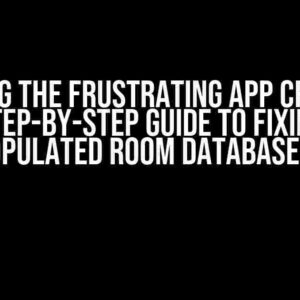Are you tired of manually updating each row in your detail table every time you make a change to the master row? Do you wish there was a way to automate this process and save your precious time? Look no further! In this article, we’ll explore the concept of master-detail relationships and learn how to modify all rows in the detail table on click of the master row.
What is a Master-Detail Relationship?
A master-detail relationship is a type of relationship between two tables in a database, where one table (the master table) has a primary key that is referenced by a foreign key in the other table (the detail table). This relationship allows you to link multiple records in the detail table to a single record in the master table.
For example, in a customer order system, the customer table is the master table, and the order table is the detail table. Each order is linked to a specific customer, and multiple orders can be placed by the same customer.
The Problem: Updating Detail Rows Manually
When you make changes to a master row, you often need to update the corresponding detail rows as well. For instance, if you change a customer’s address, you’ll need to update all the order records associated with that customer to reflect the new address.
This can be a tedious and time-consuming process, especially if you have a large number of detail rows. You’ll need to manually update each row, one by one, which can lead to errors and inconsistencies in your data.
The Solution: Modifying All Rows in the Detail Table on Click of the Master Row
Luckily, there’s a way to automate this process using programming languages like JavaScript and SQL. We’ll explore two approaches to solving this problem: using a front-end solution with JavaScript and a back-end solution with SQL.
Front-end Solution using JavaScript
In this approach, we’ll use JavaScript to update the detail rows when the master row is clicked. We’ll assume you’re using a JavaScript library like jQuery to manipulate the DOM.
Here’s an example HTML table structure for our master-detail relationship:
<table id="master">
<tr>
<td>Customer ID</td>
<td>Customer Name</td>
<td>Address</td>
</tr>
<tr>
<td>C001</td>
<td>John Doe</td>
<td>123 Main St</td>
</tr>
<tr>
<td>C002</td>
<td>Jane Doe</td>
<td>456 Elm St</td>
</tr>
</table>
<table id="detail">
<tr>
<td>Order ID</td>
<td>Customer ID</td>
<td>Order Date</td>
</tr>
<tr>
<td>O001</td>
<td>C001</td>
<td>2022-01-01</td>
</tr>
<tr>
<td>O002</td>
<td>C001</td>
<td>2022-01-15</td>
</tr>
<tr>
<td>O003</td>
<td>C002</td>
<td>2022-02-01</td>
</tr>
</table>
We’ll add a click event handler to the master table rows to update the corresponding detail rows:
<script>
$(document).ready(function() {
$("#master tr").click(function() {
var customerId = $(this).find("td:eq(0)").text();
var address = $(this).find("td:eq(2)").text();
$("#detail tr").each(function() {
if ($(this).find("td:eq(1)").text() == customerId) {
$(this).find("td:eq(2)").text(address);
}
});
});
});
</script>
This code selects the master table row that was clicked, extracts the customer ID and address, and then updates the corresponding detail rows by iterating through the detail table and updating the address column for rows that match the customer ID.
Back-end Solution using SQL
In this approach, we’ll use SQL to update the detail rows when the master row is updated. We’ll assume you’re using a relational database management system like MySQL.
Here’s an example SQL table structure for our master-detail relationship:
CREATE TABLE customers ( customer_id INT PRIMARY KEY, customer_name VARCHAR(50), address VARCHAR(100) ); CREATE TABLE orders ( order_id INT PRIMARY KEY, customer_id INT, order_date DATE, FOREIGN KEY (customer_id) REFERENCES customers(customer_id) );
We’ll create a stored procedure to update the detail rows when the master row is updated:
DELIMITER // CREATE PROCEDURE update_orders_after_customer_update( IN customer_id INT, IN new_address VARCHAR(100) ) BEGIN UPDATE orders SET address = new_address WHERE customer_id = customer_id; END// DELIMITER ;
This stored procedure takes two input parameters: `customer_id` and `new_address`. It updates the `address` column in the `orders` table for rows that match the `customer_id` parameter.
To call this stored procedure when the master row is updated, you can add a trigger to the `customers` table:
CREATE TRIGGER update_orders_after_customer_update_trigger AFTER UPDATE ON customers FOR EACH ROW BEGIN CALL update_orders_after_customer_update(NEW.customer_id, NEW.address); END//
This trigger calls the stored procedure whenever a row in the `customers` table is updated, passing the updated `customer_id` and `address` values as input parameters.
Conclusion
In this article, we’ve explored the concept of master-detail relationships and learned how to modify all rows in the detail table on click of the master row using both front-end and back-end solutions. By automating this process, you can save time and reduce errors in your data.
Remember to adapt the solutions to your specific use case and technology stack. Whether you’re using JavaScript and HTML tables or SQL and relational databases, the key is to understand the master-detail relationship and how to leverage it to update the detail rows efficiently.
FAQs
-
What is a master-detail relationship?
A master-detail relationship is a type of relationship between two tables in a database, where one table (the master table) has a primary key that is referenced by a foreign key in the other table (the detail table).
-
Why do I need to update the detail rows when the master row is updated?
You need to update the detail rows to maintain data consistency and accuracy. When the master row is updated, the corresponding detail rows should also be updated to reflect the changes.
-
Can I use this approach for other types of relationships?
Yes, this approach can be adapted for other types of relationships, such as one-to-many or many-to-many relationships. The key is to understand the relationship between the tables and how to update the related rows efficiently.
Further Reading
By following the instructions and explanations in this article, you should be able to modify all rows in the detail table on click of the master row. Happy coding!
Frequently Asked Question
Get the scoop on how to master the master-detail relationship!
How do I update all rows in the detail table when a master row is clicked?
You can use a JavaScript function to iterate through all rows in the detail table and update them accordingly when a master row is clicked. This can be achieved by adding an event listener to the master row and then using a loop to update each row in the detail table.
Can I use a stored procedure to update the detail table?
Yes, you can create a stored procedure that takes the master row ID as a parameter and updates all corresponding rows in the detail table. Then, you can call this stored procedure from your JavaScript function when a master row is clicked.
How do I ensure data consistency when updating the detail table?
To ensure data consistency, you can use transactions to wrap the update operation. This way, if any errors occur during the update process, the transaction can be rolled back to maintain data integrity.
Can I use a ORM (Object-Relational Mapping) tool to update the detail table?
Yes, you can use an ORM tool to interact with your database. These tools provide a higher-level abstraction and can simplify the process of updating the detail table. For example, you can use an ORM to retrieve all objects related to the master row and then update them accordingly.
What are some common pitfalls to avoid when updating the detail table?
Some common pitfalls to avoid include not using transactions, not handling errors properly, and not considering performance implications when updating large datasets. Additionally, ensure that your update logic is correct and doesn’t introduce data inconsistencies.


